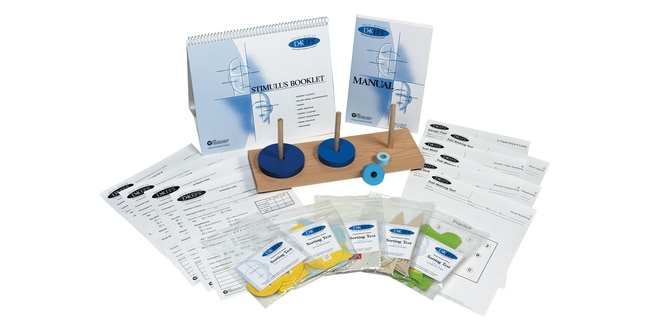D-KEFS assesses the key components of executive functions believed to be mediated primarily by the frontal lobe. With nine stand-alone tests, D-KEFS allows examiners to comprehensively assess the key components of executive functions within verbal and spatial modalities.
Administer any or all of the D-KEFS tests to customize your assessments:
- Trail Making Test
- Verbal Fluency Test
- Design Fluency Test
- Color-Word Interference Test
- Sorting Test
- Twenty Questions Test
- Word Context Test
- Tower Test
- Proverb Test
Benefits
- Assess the integrity of the frontal system of the brain.
- Determine how deficits in abstract, creative thinking may impact daily life.
- Plan coping strategies and rehabilitation programs tailored to each patient's profile of executive-function strengths and weaknesses.
- Choose from two forms: Standard and Alternate.
- Generate D-KEFS score reports faster and easier with D-KEFS Scoring Assistant® software.
Features
The D-KEFS game-like format is engaging for examinees, encouraging optimal performance without providing "right/wrong" feedback that can create frustration in some children and adults.
- Standard Record Forms, including all nine D-KEFS tests.
- Alternate Record Forms, including alternate versions of D-KEFS Sorting, Verbal Fluency, and 20 Questions tests.
- Alternate set of Sorting Cards available.
- Subtests can be recorded and scored as a complete battery or as individual subtests.
Correlates with CVLT-II
D-KEFS is correlated with the CVLT-II, providing information concerning the role of memory on D-KEFS performance.
An important study by Bohnen, Twijnstra, and Jolles (1992) was noted (p. 21) and referenced (p. 385) In the D-KEFS Examiner’s Manual (Delis, Kaplan, & Kramer, 2001). In this study, Bohnen et al. collected data from 10 patients (in the Netherlands) who had sustained mild TBIs with post-concussive symptoms that lasted longer than 3 months (the Persistent PCS group) and compared them to mild TBI patients who had recovered from their PCS symptoms after 3 months (the Recovered group). Bohnen et al. (1992) initially demonstrated that the Persistent PCS group performed significantly worse than the Recovered Group on a modified Stroop task that incorporated a switching procedure.
Dr. Manolo Sedo of Spain recently brought to our attention a second study by Bohnen, Jolles, and Twijnstra (1992), in which patients with acute mild TBI (6 to 14 days post injury) performed significantly worse than a match control group on the modified Stroop task that incorporated a switching procedure.
We wish to thank Dr. Sedo for drawing our attention to this important study.
Bohnen, N., Twijnstra, A., & Jolles, J. (1992). Performance in the Stroop color word test in relationship to the persistence of symptoms following mild head injury. Acta Neurologica Scandinavica, 85(2), 116–121.
Bohnen, N., Jolles, J., & Twijnstra, A. (1992). Modification of the Stroop color word test improves differentiation between patients with mild head injury and matched controls. The Clinical Neuropsychologist, 6(2), 178–184.

